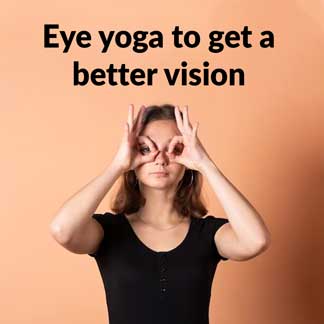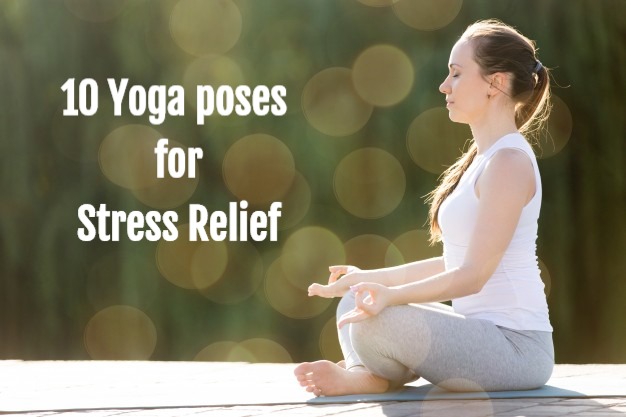In the past, children would use their free time to play in the sand, stones and other outdoor activities. Now, however, kids from all age groups spend their leisure time in front of the television, their mobile phones, tablets, laptops, PlayStations, and iPods.
This has led to an increase in vision problems at a young age. Adults, too, are spending a majority of their time with these gadgets, not just during their leisure time; these gadgets have become essential for them. This causes greater stress on the eyes and its components.
Yoga offers some simple exercises that can help relieve eye strain. Many of the yogic exercises are geared towards improving the functioning of specific body parts. There are a number of eye exercises that are included in yoga that help with eye-related problems such as nearsightedness and farsightedness. Doing these exercises can help your eyes feel better.
Yoga techniques for the eyes help to improve various disorders related to defects in the eye muscles such as myopia and Hypermetropia.
So, without any further ado, let’s get started!

What is eye yoga?
Eye yoga is a holistic approach to vision improvement that involves a series of simple exercises and relaxation techniques. It is a great way to improve vision, reduce eyestrain, and relax the eyes.
Although the term “yoga” is often associated with the physical practice of stretching and flexibility, yoga is actually a state of being where the mind, body, and spirit are in harmony.
There are a range of yoga practices that can be used to address different issues, from anxiety and depression to insomnia, back pain, and (of course) vision issues. Eye yoga is a practice that includes a series of exercises and techniques that are aimed at improving vision, reducing stress, and promoting relaxation, calmness, and inner balance.
Benefits of eye yoga
There are a number of benefits associated with practicing eye yoga. Here are some of them:
– Improved vision
Eye yoga exercises help to promote circulation in the eyes and improve overall vision. Studies have shown that there is a connection between the eyes and the central nervous system. By improving the health of the eyes, we can promote general vision improvement.
– Alleviation of eyestrain
Eye yoga promotes relaxation and helps to reduce eyestrain. When we are stressed or anxious, our eyes tense up and have a tendency to go out of alignment. Over time, this can cause permanent strain on the eyes, leading to vision problems and eye fatigue.
– Relaxation and improved mental health
One of the most significant benefits of eye yoga is its ability to promote relaxation and improve mental health.
– Increased energy and vitality
Eye yoga promotes relaxation and reduces stress, which can help to increase energy and vitality.
Yoga exercises for weight loss
1. Palming

Wash your hands before the practice!
Short Practice
Generate some warmth by rubbing your palms together. Then, lightly place the palms of your hands over your eyes. You can either keep them open or shut. Let your eyes move naturally. Take a few deep, conscious breaths. After a few minutes, remove your hands from your face. If you can, repeat the exercise multiple times.
Longer Practice
- Decide to recline or sit up. Ensure that you feel comfortable by utilizing a cushion or pillow to prop up your arms and wrapping yourself with blankets to make sure you’re cozy.
- If you practice palming for an extended period, you can listen to your favourite tunes, radio station, or podcast. You could also recall a joyful recollection with all of your senses. For example, envision a bright day on the beach. Recall the sound of the surf, the scent of the ocean, the sensation of the water on your skin, and the flavour of the ice cream.
- Once you feel you are finished with the palming technique, take away your hands gradually and open your eyes gradually to accustom them to the brightness. Blink your eyes a few times gently.
- An eye pillow or mask can be substituted for your hands while practicing relaxation techniques, but it is often more soothing to use your own body heat.
- It’s advisable to increase the duration of palming gradually to prevent your arms and hands from becoming excessively exhausted.
Benefits
Resting the eyes through palming is a great way to relax and energize the eye muscles, as well as increase the flow of aqueous humour, the fluid located between the cornea and the lens of the eye, which can help improve vision problems.
2. Blinking
- Get yourself into a comfortable position and open your eyes.
- Rapidly blink 10 times, then shut your eyes and relax for 20 seconds, focusing on your breathing.
- Do this cycle around 5 times.
Benefits
Individuals who have trouble with their vision tend to blink unconventionally and erratically. This is caused by a continual strain of the eyes. This exercise helps the blinking reflex to become more natural and reduces the tension in the eye muscles.

3. Sideways Viewing
- Position your legs in an extended posture directly in front of you.
- Elevate your arms while keeping your fists closed and your thumbs facing up.
- Focus your gaze on an object that is even with your eye line.
- Keep the head in this fixed position, focus on the following one after the other, by shifting your vision to the
– Space between the eyebrows
– Left thumb
– Space between the eyebrows
– Right thumb
– Space between the eyebrows
– Left thumb - Repeat the same process for around 10 to 20 times.
- Once you are done with the exercise, close your eyes and let yourself relax.
PS: Try to observe your breathing pattern while your perform this exercise.
– Neutral position – Inhale
– while looking sidewards – Exhale
– Coming back to the center – Inhale
Find out more in this video:
![Eye Yoga Series- Sequence 3 [Viewing Sideways] - Yoga for All- Improve your eyesight at any age](https://i.ytimg.com/vi/96_LotDhaiM/maxresdefault.jpg)
Benefits
Taking a break from staring at something and looking off to the side helps ease the stress of constantly staring at things while doing close work and reading. Additionally, it helps prevent and fix crossed eyes.
4. Front and sideways viewing
- You have to stay in the same position as you were in the above exercise.
- Put your left hand on your left leg with your thumb facing upwards.
- Place the right thumb away from the body and then angle it upwards.
- Without turning one’s head, one should look successively at the left thumb and then the right thumb before focusing their gaze back on the left thumb.
- Repeat the above steps around 10 times. Once you are done, close your eyes and relax yourself.
- Now, repeat the same process on the other side of the body.
- Ensure that your head and spine are straight throughout.
- Once you are done, time to rest.
- You can do palming after this to relax.

Benefits
Seeing objects from different angles can assist in bettering coordination between the muscles located at the inner and outer sides of the eye.
This will help further:

5. Up and down viewing
- Position your legs in an extended posture directly in front of you.
- Position both hands on the lap with the thumbs facing upwards.
- With arms outstretched, lift the left thumb up in a gradual manner, observing its movements with your vision.
- Once the thumb is raised as far as it can go, undo the motion and keep your eyes on the thumb without shifting your head.
- Rest for a while and repeat on the other hand.
- You can repeat this exercise 10 times with each thumb.
- Ensure that your head and spine are positioned straight.
- Once done, rest for a while. You can also perform palming to relax your eyes.
While raising the eyes – Inhale
While lowering the eyes – Exhale
Benefits
This exercise works out the muscles in the top and bottom of the eyes.
Find out the detailed guide here:





